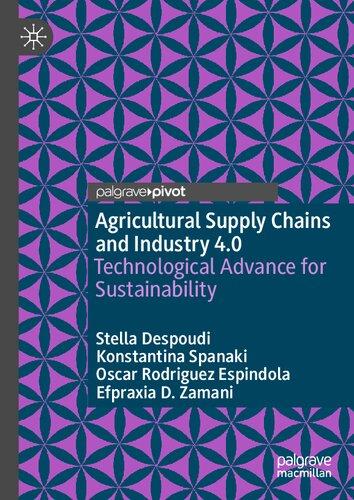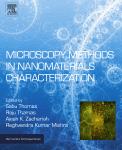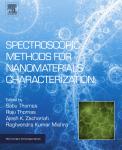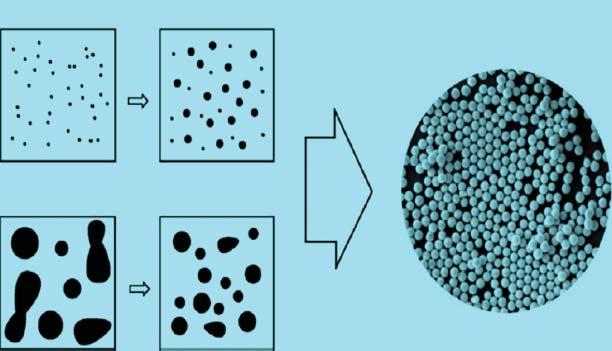Nano-Technological Intervention in Agricultural Productivity 1st Edition Javid A. Parray
Visit to download the full and correct content document: https://ebookmass.com/product/nano-technological-intervention-in-agricultural-produc tivity-1st-edition-javid-a-parray/

More products digital (pdf, epub, mobi) instant download maybe you interests ...

Soil Bioremediation: An Approach Towards Sustainable Technology Javid A. Parray
https://ebookmass.com/product/soil-bioremediation-an-approachtowards-sustainable-technology-javid-a-parray/

Agricultural Supply Chains and Industry 4.0: Technological Advance for Sustainability Stella Despoudi
https://ebookmass.com/product/agricultural-supply-chains-andindustry-4-0-technological-advance-for-sustainability-stelladespoudi/

Nonlinear Differential Equations in Micro/Nano Mechanics: Application in Micro/Nano Structures and Electromechanical Systems 1st Edition Ali Koochi
https://ebookmass.com/product/nonlinear-differential-equationsin-micro-nano-mechanics-application-in-micro-nano-structures-andelectromechanical-systems-1st-edition-ali-koochi/

Microscopy Methods in Nanomaterials Characterization. A volume in Micro and Nano Technologies 1st Edition Edition Sabu Thomas
https://ebookmass.com/product/microscopy-methods-innanomaterials-characterization-a-volume-in-micro-and-nanotechnologies-1st-edition-edition-sabu-thomas/

Employees’ Emotional Intelligence, Motivation & Productivity, and Organizational Excellence : A Future Trend in HRD 1st Edition
Gagari Chakrabarti
https://ebookmass.com/product/employees-emotional-intelligencemotivation-productivity-and-organizational-excellence-a-futuretrend-in-hrd-1st-edition-gagari-chakrabarti/

Spectroscopic Methods for Nanomaterials
Characterization. A volume in Micro and Nano Technologies 1st Edition Edition Sabu Thomas
https://ebookmass.com/product/spectroscopic-methods-fornanomaterials-characterization-a-volume-in-micro-and-nanotechnologies-1st-edition-edition-sabu-thomas/

Essentials
of Dyslexia Assessment and Intervention 1st Edition
https://ebookmass.com/product/essentials-of-dyslexia-assessmentand-intervention-1st-edition/

The AI Revolution in Project Management: Elevating Productivity with Generative AI 1st Edition Kanabar
https://ebookmass.com/product/the-ai-revolution-in-projectmanagement-elevating-productivity-with-generative-ai-1st-editionkanabar/

A Guide to Crisis Intervention 6th Edition Kristi Kanel
https://ebookmass.com/product/a-guide-to-crisis-intervention-6thedition-kristi-kanel/
Nano-TechnologicalInterventioninAgriculturalProductivity
Nano-TechnologicalInterventioninAgricultural Productivity
JavidA.Parray
DepartmentofHigherEducation GovernmentDegreeCollegeEidgah Srinagar,India
MohammadYaseenMir DepartmentofSchoolEducation UniversityofKashmir Srinagar,India
NowsheenShameem DepartmentofEnvironmentalScience ClusterUniversitySrinagar JammuandKashmir,India
Thiseditionfirstpublished2021 ©2021JohnWiley&SonsLtd.
Allrightsreserved.Nopartofthispublicationmaybereproduced,storedinaretrievalsystem,or transmitted,inanyformorbyanymeans,electronic,mechanical,photocopying,recordingorotherwise, exceptaspermittedbylaw.Adviceonhowtoobtainpermissiontoreusematerialfromthistitleisavailable athttp://www.wiley.com/go/permissions.
TherightofJavidA.Parray,MohammadYaseenMirandNowsheenShameemtobeidentifiedasthe author(s)ofthisworkhasbeenassertedinaccordancewithlaw.
RegisteredOffice
JohnWiley&Sons,Inc.,111RiverStreet,Hoboken,NJ07030,USA
JohnWiley&SonsLtd,TheAtrium,SouthernGate,Chichester,WestSussex,PO198SQ,UK
EditorialOffice
TheAtrium,SouthernGate,Chichester,WestSussex,PO198SQ,UK
Fordetailsofourglobaleditorialoffices,customerservices,andmoreinformationaboutWileyproducts visitusatwww.wiley.com.
Wileyalsopublishesitsbooksinavarietyofelectronicformatsandbyprint-on-demand.Somecontentthat appearsinstandardprintversionsofthisbookmaynotbeavailableinotherformats.
LimitofLiability/DisclaimerofWarranty
Thecontentsofthisworkareintendedtofurthergeneralscientificresearch,understanding,anddiscussion onlyandarenotintendedandshouldnotberelieduponasrecommendingorpromotingscientificmethod, diagnosis,ortreatmentbyphysiciansforanyparticularpatient.Inviewofongoingresearch,equipment modifications,changesingovernmentalregulations,andtheconstantflowofinformationrelatingtothe useofmedicines,equipment,anddevices,thereaderisurgedtoreviewandevaluatetheinformation providedinthepackageinsertorinstructionsforeachmedicine,equipment,ordevicefor,amongother things,anychangesintheinstructionsorindicationofusageandforaddedwarningsandprecautions. Whilethepublisherandauthorshaveusedtheirbesteffortsinpreparingthiswork,theymakeno representationsorwarrantieswithrespecttotheaccuracyorcompletenessofthecontentsofthisworkand specificallydisclaimallwarranties,includingwithoutlimitationanyimpliedwarrantiesofmerchantability orfitnessforaparticularpurpose.Nowarrantymaybecreatedorextendedbysalesrepresentatives,written salesmaterialsorpromotionalstatementsforthiswork.Thefactthatanorganization,website,orproduct isreferredtointhisworkasacitationand/orpotentialsourceoffurtherinformationdoesnotmeanthat thepublisherandauthorsendorsetheinformationorservicestheorganization,website,orproductmay provideorrecommendationsitmaymake.Thisworkissoldwiththeunderstandingthatthepublisheris notengagedinrenderingprofessionalservices.Theadviceandstrategiescontainedhereinmaynotbe suitableforyoursituation.Youshouldconsultwithaspecialistwhereappropriate.Further,readersshould beawarethatwebsiteslistedinthisworkmayhavechangedordisappearedbetweenwhenthisworkwas writtenandwhenitisread.Neitherthepublishernorauthorsshallbeliableforanylossofprofitorany othercommercialdamages,includingbutnotlimitedtospecial,incidental,consequential,orother damages.
LibraryofCongressCataloging-in-PublicationDataappliedfor HardbackISBN:9781119714859
CoverDesign:Wiley
AbouttheAuthors vii
AbouttheBook ix
1NanotechnologyandNanoparticles 1
2ImplicationsofNanotechnologyandEnvironment 21
3NanotechnologyandDiseaseManagement 37
4NanotechnologyinAgri-FoodProduction 59
5Nanotechnology:ImprovementinAgriculturalProductivity 73
6LigninNanoparticles:SynthesisandApplication 97
7ContemporaryApplicationofNanotechnologyinAgriculture 109
8Nanotechnology:AdvancesinPlantandMicrobialScience 131
9FoodApplicationandProcessing:NanotechniquesandBioactiveDelivery Systems 161
Index 197
AbouttheAuthors
Dr.JavidA.Parray,PhD,isanAssistant ProfessorintheHigherEducationDepartment attheGovernmentDegreeCollegeEidgah,Srinagar,India,whereheteachesthesubjectof environmentalscience.Hehaspublishedmany researcharticlesinreputablerefereedinternationalandnationaljournals.Hehadauthored booksondifferentthemes,includingApproaches toHeavyMetalToleranceinPlants;SustainableAgriculture:BiotechniquesinPlantBiology; andSustainableAgriculture:AdvancesinPlant MetabolomeandMicrobiome,soilbioremediation,climatechangeandmicrobes,etc.Hewas awardedthe‘ScientistoftheYearAward’bythe IndianAcademyofEnvironmentalSciencefortheyear2015inadditiontobeingawarded withaninternationaltravelgrantforparticipatingininternationalconferences.Heiscurrentlytheeditorandreviewerofmanyreputedjournals.HeisalsothefounderofAcademy ofEcoscience.Dr.Parraycompletedafast-trackprojectentitled‘Molecularcharacterization andmetabolicpotentialofrhizosphericbacteriafrom Arnebiabenthamii acrossNorthWesternHimalaya’atCORD,UniversityofKashmir,India.Hefinishedhispostdoctoralresearch associateshiponaDBT-fundedprojectentitled‘Tissueculture-basednetworkprogramme onsaffron’.HeearnedaPhDdegreeinenvironmentalsciencewithaspecializationinplant microbeinteractionsonthetopic‘Evaluatingroleofrhizosphericbacteriainsaffronculture’ fromtheUniversityofKashmir,India.Dr.Parrayisalsothesubjectcoursecoordinatorfor EnvironmentalScienceApprovedCEC-MoocsbyMHRD,GovernmentofIndia,NewDelhi.



Dr.MohammadYaseenMir wasworkingas aseniorresearcherinResearchprojectfunded byMinistryofEnvironment,Forest&Climate Change(MoEF&CC),GovernmentofIndiaalong withG.B.PantNationalInstituteofHimalayan Environment&SustainableDevelopmentunder NationalMissiononHimalayanStudies(NMHS) andhasrecentlyjoinedDepartmentofEducationJ&Kasateacher.HedidhisM.Philand Ph.DProgrammesfromtheUniversityofKashmir. Hepublishedmanyresearcharticlesinreputed, referredinternationalandnationaljournalslike Springer/Elsevier/Hindwaii.Hehasalsoauthored bookSustainableAgriculture:Biotechniquesin PlantBiologywithspringer.
Dr.NowsheenShameem(M.Phil,Ph.D) is currentlyworkingasanAssistantProfessor(CL) intheDepartmentofEnvironmentalScienceat ClusterUniversitySrinagar,JammuandKashmir, India.Shedidherdoctorate(PhD)fromthe UniversityofKashmironnutraceuticalvalueof wildmushroomsgrowinginKashmirvalleyinthe year2017.Shehasresearchexpertiseinmicrobial biotechnology,plantbioactivityandbiotechnology,medicinalchemistry,andplantmicrobe interactions.Shepublishedmanyresearcharticles inreputed,referredinternationalandnational journalssuchasSpringer,Elsevier,andHindawi. Shehasalsoauthoredmanybooksonthemessuch asfreshwatermicrobiology,plantbiotechniques, advancesinplantmetabolomeandmicrobiome,andclimatechangesandmicrobes.Sheis alsotherecipientoftheJuniorScientistoftheYearawardbytheInternationalFoundation forEnvironment&Ecology.
AbouttheBook
Contemporaryagriculturesharestheimportantportionofglobaleconomyforany sought-aftergrowth,especiallyforitsmajorcontributiontohumanupliftmentthrough povertyeradication,fastindustrialization,financialchangeandinvestment,sustainable resourceusage,andenvironmentalmanagement.Theminiatureaspectofnanotechnology controlsmajoragriculturalprocessesbecauseofitsdiminutivedimensions.Inaddition, theuseofnanotechnologiescanberesonantobstruction,thankstothemanypotential advantagessuchasenhancingthequalityandsafetyoffood,decreasingagriculturalinputs, andenhancingsoilabsorptionofnanoscalenutrients.Thisbookwillbeimmenselyhelpful tothestudentsofplantbiotechnology,agriculturalsciences,andagriculturalengineering studentsofbothundergraduateandpostgraduatelevelsinuniversities,colleges,and researchinstitutes.Thebookwillsupportresearcherswhoworkinthefieldofplant biotechnologyandagriculturalsciences.Itishopedthisbookwillbeanothersteptowards thebeneficialapproachinplantbiotechnologyandsettingofanewarenainshapingthe newbiotechniquestowardsthesustainablecause.
Keyfeatures:
1.Nanotechnologicalinnovationsinplantbiology
2.Nanotechnologyandtransgenicviagenomeeditingtowardssustainableagricultural systems
3.Nanofertilizersandnanopesticides
4.Nanoparticleprotectioninplants.
NanotechnologyandNanoparticles
CHAPTERMENU
NanoparticlesandTheirFunctions,1 ClassificationofNPs,2 Carbon-BasedNPs,2 MetalNanoparticles,2 CeramicNPs,3 SemiconductorNPs,3 PolymericNPs,3 NPsBasedonLipids,4 SynthesisofNanoparticles,4 Top-DownSynthesis,4 Bottom-UpSynthesis,5 NPsandCharacterization,6 MorphologicalCharacterization,6 StructuralCharacteristics,7 ParticleSizeandSurfaceAreaCharacterization,8 OpticalCharacterizations,8 PhysicochemicalPropertiesofNPs,9 MechanicalandOpticalProperties,9 MagneticProperties,9 MechanicalProperties,10 ThermalProperties,10 FunctionsofNPs,10 DrugsandMedications,11 MaterialsandManufacturing,11 Environment,12 Electronics,12 EnergyHarvesting,12 References,13
1.1NanoparticlesandTheirFunctions
Sincethepastcentury,nanotechnologyhasbeenanadvancedresearcharea.RPFeynman coinedtheterm‘nanotechnology’duringhisfamousspeech[1].Nanotechnologydevelopeddifferenttypesofnanoscalematerials.Alimitedclassofone-dimensionalmaterials <100nm[2]arenanoparticles(NPs).Dependingontheform[3],suchmaterialsmaybe 0D,1D,2D,or3D.Theimportanceofthesematerialsshowedthatthephysicochemical Nano-TechnologicalInterventioninAgriculturalProductivity, FirstEdition. JavidA.Parray,MohammadYaseenMirandNowsheenShameem. ©2021JohnWiley&SonsLtd.Published2021byJohnWiley&SonsLtd.
1NanotechnologyandNanoparticles
propertiesofasubstance,e.g.theopticalproperties,canbeinfluencedbysize.Theredwine, yellowish-grey,black,anddeepgreenarethedistinctivecoloursofthe20nmgold(Au), platinum(Pt),silver(Ag),andpalladium(Pd)NPs.TheseNPsexhibitdistinctivecolours andpropertiesofvarioussizesandshapesthatcanbeusedinbioimagingapplications.[4]. Owingtodifferencesinaspectratio,nanoshellthickness,andAuconcentration,thesolution’scolourvaries.Changingeachoftheelementsmentionedaboveaffectstheabsorption characteristicsoftheNPsandisthereforeobservedindifferentabsorptioncolours.Usually, NPsconsistofthreelayers:(i)alayer-functionalizedsurfacewithseveraltinymolecules, metalions,surfactants,andpolymers;(ii)ashelllayer–achemicallyseparatecoresubstance;and(iii)acentre–anintegralpartoftheNPandtypicallyreferstotheNPitself[5]. Researchersgainedimmenseinterestinmultidisciplinaryfieldsbecauseoftheseexceptionalfeatures.NPsmaybeusedforthedeliveryofdrugs[6],chemicalandbiological sensing[7],gassensing[8],CO2 capture[9],andrelateduses[10].
1.2ClassificationofNPs
NPsarecommonlyclassifiedaccordingtomorphology,size,andchemicalpropertiesin differentclasses.NPsareclassifiedaccordingtophysicalandchemicalcharacteristicsas follows.
1.2.1Carbon-BasedNPs
TwokeyNPgroupsbasedoncarbonarefullerenesandcarbonnanotubes(CNTs). Fullerenescontainglobularhollowcagenanomaterials,similartoallotropiccarbon forms.Theirelectricalconductivity,highpower,structure,electronaffinity,andflexibility havecreatedconsiderablecommercialinterest[11].PentagonalandhexagonalC-units werearrangedinthesematerialswhileeachcarbonwashybridized.Theillustrationin Figure1.1showssomeofthewell-known7.114and7.648nmC60 andC70 fullerenes.The long,tubularCNTshaveadiameterof1–2nm[12].Thiscanbepredictedasmetallicor semiconductingbasedontheirtelicitydiameter[13].Single,double,ormultiplewalls mayberollingsheetslabelledsingle-wallednanotubes(SWNTs),double-wallednanotubes (DWNTs),ormulti-walledcarbonnanotubes(MWNTs),respectively.Theyarecommonly synthesizedbycarbonprecursordeposition,particularlyatomiccarbons,whichare vaporizedbyalaserorelectricarcthroughmetalparticles.Recently,theyhavebeen synthesizedusingthechemicalvapourdeposition(CVD)technique[14].Becauseoftheir specificphysical,chemical,andmechanicalcharacteristics,thesematerialsarewidely usedinindustrialapplications,notonlyinpristineformbutalsoinnanocompositessuch asfillers[15],activegasadsorbentsfortheremediationoftheenvironment[16],and,in general,forvariousinorganicandorganiccatalysts[17].
1.2.2MetalNanoparticles
MetalNPscomprisemetal-madeprecursors.Becauseofthewell-localizedsurfaceplasma resonance(LSPR)characteristics,suchNPshavedistinctoptoelectronicproperties.Inthe visibleregionofthesolarelectromagneticspectrum,theNPsofalkaliandnoblemetals

Figure1.1 Descriptionoffullerenesorbuckballs(a)C60 and(b)C70 .Source:FromKhanetal.[2]. ©2017,Elsevier.
suchasCu,Ag,andAuhavebroadbandabsorption.Intoday’scutting-edgematerials,the facet,size,andshape-controlledsynthesisofmetalNPsarecritical[4].MetalNPsarefindingapplicationsinmanyresearchfieldsbecauseoftheiradvancedopticalproperties.The coatingofgoldNPsiswidelyusedtoenhanceelectronicstreamingforscanningelectron microscopy(SEM)sampling,thushelpingtoaccomplishgoodSEMimages.
1.2.3CeramicNPs
NPsfromceramicsareinorganicnon-metallicsolidssynthesizedbyheatandcooling.They areusedinamorphous,polycrystalline,solid,porous,orhollow[18]forms.Becauseoftheir useincatalysis,photocatalysis,colourphotodegradation,andimaging,theseNPsoffersubstantialinterestfromresearchers[19].
1.2.4SemiconductorNPs
Semiconductormaterialshavepropertiesbetweenmetalsandnon-metals,andbecauseof thisproperty,theyfinddifferentapplicationsintheliterature[20].SemiconductorNPshave largebandgaps,demonstratingsignificantmodificationstotheirpropertieswithbandgap tuning.Itemsofgreatsignificancealsoincludephotocatalysis,photo-optics,andelectronic devices[21].Becauseoftheirappropriatebandgapandbandedgepositions,therangeof semiconductorNPsisconsideredexceptionallyefficientinwatersplittingapplications[22].
1.2.5PolymericNPs
Thesesubstancesareusedforawiderangeofcommercialapplications,suchasfillers[15], effectiveadsorbentsofenvironmentalremedialgases[16],andasasupportmediumfor variousinorganicandorganiccalculatorsbecausetheygivespecificphysical,chemical,and mechanicalcharacteristics[23].
1.2.6NPsBasedonLipids
Inmanybiomedicalapplications,theyareused,andtheycontainlipidmolecules.Usually, thelipidNPisspherical,10–1000nmindiameter.SimilartopolymericNPs,lipidNPshave asolidlipidcoreandlipophilicmoleculeswithinthematrix.Theexternalcentreofthese NPshasbeenstabilizedbysurfactantsoremulsifiers[24].Lipidnanotechnology[25]isa specificfieldthatfocusesonthedesignandsynthesisoflipidNPsforvariousapplications, suchasdrugcarriersanddelivery[26]andthereleaseofRNAcancertherapy[27].
1.3SynthesisofNanoparticles
VarioustechniquescanbeusedforthesynthesisofNPs.Nevertheless,theseapproachesare generallydividedintotwomaincategories,i.e.(i)top-downapproachand(ii)bottom-up approach[28,29](Figure1.2).Thesemethodsarefurtherdividedintodifferentsubclasses basedonprocess,reactionstate,andadoptedprotocols.
1.3.1Top-DownSynthesis
Thelargermoleculesaredisintegratedintosmallerunitsbyadestructiveprocess,and theseunitsaretransformedintousefulNPs,forexample,grinding/milling,CVDs,physical vapourdeposition,etc.[29].ThisapproachisgenerallyusedtosynthesizeNPsfrom coconutshells(CSs).Themillingmethodisused,wherebyrawCSpowderswerefinely milledusingceramicballsandawell-knownplanetarymillatdifferenttimeintervals.Via othercharacterizationtechniques,theinfluenceofthemillingperiodontheoverallsizeof theNPsisshown.
Furthermore,astimeincreases,thesizeoftheNPcrystallite(Scherrerequation) decreases.Inthisprocess,itwasalsofoundthatthebrownishcolourfadedaway withtheincrementofeachhourbecauseofthereducedsizeoftheNPs[30].Various
i. Spinning
ii. Template support
iii. Plasma or flame synthesis
iv. Laser pyrolysis
v. CVD
vi. Atomic or molecular condensation
Top-down process
i. Chemical etching
iii. Sputtering
iv. Laser ablation

ii. Mechanical milling
v. Electro-explosion
Figure1.2 ThesyntheticmodelsofNPs:top-downandbottom-upapproach.Source:Modified fromIravani[29].
characterizationtechniquesdemonstratedtheeffectofmillingtimeontheoverallsizeof theNPs.ThesynthesisofsphericalmagnetiteNPsfromnaturalironoxide(Fe2 O3 )ore wasshowninthepresenceoforganicoleicacidbyadestructivetop-downmethodwitha particlesizerangingfrom20to50nm[31].Tosynthesizesphericalparticlesofcolloidal carbonusingacontrolscale,aprimarytop-downroutewasused.Thesynthesistechnique wasbasedonthecontinuouschemicaladsorptionofpolyoxometalatesonthecarbon interfacialsurface.Adsorptionhastransformedblackcarbonaggregatesintorelatively smallersphericalparticleswithahighdispersioncapacityandanarrowdistributionof size[32].Microstructureshavefoundthatthequantityofcarbonparticlesislowerduring thesonicationperiod.Combinedgrindingandtop-downsonicationtechniquessynthesizedasequenceoftransitionmetaldichalcogenidenanodots(TMD-NDs)fromtheir crystallites.EveryTMD-NDwithasizeoflessthan10nmshowsexcellentdispersionand isdemonstratedbythenarrowdistributionofthemeasure[33].HighlyphotoactiveCo3 O4 NPshaverecentlybeenproducedbytop-downlaserfragmentation,i.e.atop-downprocess withanaveragesizeof5.8 ± 1.1nm.Powerfullaserirradiationsproducewell-uniformed NPswithadequateoxygenvacancy[34].
1.3.2Bottom-UpSynthesis
ThisreverseapproachisusedtosynthesizeNPsfromrelativelymorestraightforward substancesandisalsocalledanapproachtobuildingup.Examplesincludesedimentation andreductiontechniques.Itencompassessun-freezing,greensynthesis,spinning,and biochemicalsynthesis[29].Mogilevskyetal.[35]usedthistechniquetosynthesizeTiO2 anataseNPstothegraphenedomains.Alizarinandtitaniumisopropoxideprecursors havebeenusedtosynthesizethephotoactivecompositeformethylenebluephotocatalyticdegradation.TheX-raydiffraction(XRD)frameworkhasverifiedtheanatase form[35].Well-uniformsphericalshapedAunanosphereshavebeensynthesizedwith monocrystallineusingtop-downlaserirradiationtechnique[36,37].Recently,thesolvent exchangemethodhasbeenusedtodelivermedicalcancerdrugstoachievelimited-size low-densitylipoprotein(LDL)NPs.Thestandardapproachfollowedbygrowth,i.e.up process,isnucleationinthistechnique.TheLDLNPswereobtainedwithoutphospholipiduseandhadhighhydrophobicity,whichisaprerequisitefordrugdelivery implementation.[38].Themonodispersedsphericalbismuth(Bi)NPs,withtop-down andbottom-upapproaches,aresynthesizedwithexcellentcolloidalproperties[39].In bottom-upethyleneglycol,bismuthacetatewasmelted,althoughbismuthwasconverted intoamoltenstateinthetop-downprocess.Inboileddiethyleneglycol,themoltendrop thenhasbeenemulsifiedforNPs.BothmethodsgenerateddifferentNPsinsizefrom100 to500nm[39](Figure1.3a,b).Greenandbiogenicbottom-upprocessingiscost-effective andenvironmentallysustainable,wherebiologicalprocesses,suchasusingplantextracts, achievethesynthesisofNPs.ForthesynthesisofNPs,bacteria,yeast,fungi, Aloevera, tamarind,andevenhumancellsareused.Au-NPsweresynthesizedfromwheatbiomass andoat[40]andusedasareductionagentbymicroorganismsandplantextracts[41,42]. Figure1.3demonstratedthebottom-up(Figure1.3a)method:decomposingamolecular precursorintosimplemetalatoms,whichtransformintocolloidsandthetop-down (Figure1.3b)method.

Figure1.3 Illustrationofsynthesisofnanoparticles:(a)top-downmethodand(b)bottom-up method.Source:FromWangandXia[39].©2004,AmericanChemicalSociety.
1.4NPsandCharacterization
FortheanalysisofotherphysicochemicalpropertiesofNPs,differentmethodsofcharacterizationhavebeenused,suchasXRD,X-rayphotoelectronspectroscopy(XPS),infrared (IR),SEM,transmissionelectronmicroscopy(TEM),andBrunauer–Emmett–Teller(BET). Advancedmethodsareappliedfortheanalysisoftheparticles.
1.4.1MorphologicalCharacterization
ThemorphologicalcharacteristicsofNPsarestillofgreatimportanceasmorphologystill affectsmostoftheNPproperties.Variouscharacterizationtechniquesexistformorphologicalresearch,butmicroscopicmethodsexist,suchaspolarizedopticalmicroscopy(POM), SEM,andTEM.
1.4.1.1SEMTechnique
TheSEMtechniqueisbasedontheelectronscanningprincipleandprovidesallthe nanoscaleNPdataavailable.Thistechniqueisusedtostudythemorphologyoftheir nanomaterialsandthedispersionofNPsinthebulkormatrix.Thistechnique[15]showed thedistributionofSWNTsinpolymermatrixpoly(butylene)terephthalate(PBT)and nylon-6.ThemorphologicalcharacteristicsofZnO-modifiedmetal–organicframeworks (MOFs)werestudiedusingtheSEMtechnique,whichindicatesthedispersionofZnO-NPs andMOFs’morphologiesunderdifferentreactionconditions[43].
1.4.1.2TEMTechnique
Itisbasedontheelectrontransferprinciple,sothatitcanprovidedescriptionsofthebulk contentfromverylowtogreatermagnification.Inaddition,itiscommonlyusedforthe analysisofdifferentmorphologiesoftheAu-NPs[44].TEMalsoprovidesessentialinformationabouttwo-ormorelayermaterials;thequadruplehollowshellstructureofCo3 O4
NPsisobservedbyTEM,forinstance.InLi-ionbatteriessuchastheanode,theseNPshave proventhemselvestobeexceptionallyefficient.Theporousmulti-shellstructureinduces shorterLi+ diffusionpathlengthswithampleannulledspaceforbuffervolumeexpansion, goodcyclingefficiency,higherspeedcapacity,andessentialcapacity[45].
1.4.2StructuralCharacteristics
Thestructuralcharacteristicsofthestructureandfunctionofthebondingmaterialsareof primaryimportanceforstudying.Itgivesdetailsaboutthebulkpropertiesofthesubject material.XRD,energy-dispersiveX-ray(EDX)spectroscopy,XPS,IR,Ramanspectroscopy, BET,andZietasizeanalyserarethetechniquesusedtostudythestructuralproperties ofNPs.
1.4.2.1XRD
Oneoftheessentialcharacterizationtechniquesistorevealthestructuralpropertiesof NPs.ThecrystallinephaseofNPsisprovidedwithsufficientdata.Italsoprovidesarough imageoftheparticlesizethroughtheDebye–Scherrer[8]formula.Intheidentificationof singleandmultiphaseNP[46]schemes,thisapproachworkedwell.However,insmaller NPswithasizesmallerthanhundredsofatoms,theacquisitionandaccuratemeasurement ofstructuralandotherparametersmaybedifficult.Besides,theXRDdiffractogramcanbe affectedbyNPswithdifferentinteratomiclengthshavingmoreamorphouscharacteristics. Toobtainaccuratedata,thediffractogramsofbimetallicNPsmustbecontrastedwiththose ofthecorrespondingmonometallicNPsandtheirphysicalmixturesinthiscase.Thebest waytomakeasubstantialdifferenceistomeasurethesimulatedbimetallicNPstructural modelwiththespectraofXRD[47]observed.
1.4.2.2Energy-DispersiveX-ray(EDX)
Tounderstandtheelementarycompositionwitharoughideaofpercentweight,ausually fixedfieldemissionscanningelectronmicroscopy(FE-SEM)orTEMsystemiscommonly used.TheelectronbeamcentredonasingleNPthroughSEMorTEMthroughthesoftwarefunctionstoobtaintheinsightknowledgeunderobservationfromtheNP.NPconsists ofconstituentelementsand,byirradiatingelectronbeams,eachofthesereleasesX-ray energycharacteristics.TherealX-rayintensityisdirectlyproportionaltotheexplicitpart oftheparticle’sconcentration.Researchersinpreparatorymaterialscommonlyusethis techniquetohelpSEMandotherprocessestovalidatetheircomponents[48].Theelementalcompositionofultra–sonochemicallysynthesizedBiVO4 NPsinpseudo-flowerform [49]wascalculatedusingtheEDXtechnique.Similarly,asimilarapproachwasusedto performtheindispensableconfirmationandgrapheneimpregnationofLn2 O3 /graphene heterostructureNPs,whichshowedC,Ln,andOascontributingelementssynthesizedby thetraditionalhydrothermalmethod[50].
1.4.2.3XPS
Itisasurface-sensitivetoolandcanbeusedtoconsidertheoverallcompositionandthe compositionalvariancewithin-depthprofilingstudies.XPSisbasedonthebasicprinciples ofspectroscopy.ThetypicalXPSspectrumconsistsofthenumberofelectronsonthe Y -axis
plotversusthe X -axiselectrons’bindingenergy(eV).Eachelementhasitsfingerprintvalue forenergybindingandthusgivesaparticularsetofXPSpeaks.Correspondingpeaks,such as1s,2s,2p,and3s,comefromtheelectronicconfiguration[51].Toresearchthedispersion ofBoronNPs(10nmsize)duringfunctionalizationwithpolyethyleneglycol(PEG),adepth profileanalysiswasgivenwithAr+ ionsat1.4keVand20nm.Ithasbeenshownthatthe concentrationofNPsincreasesfrom2%to5%withdepth.Thisofferedstrongevidencethat withinthebulkoffunctionalizedPEG,boronNPsareeffectivelydissolved[52].Inarelated analysis,core–shellAu/AgshowedsimilarbehaviourthroughXPSscopeprofiling[53].
1.4.2.4FT-IRandRamanSpectroscopies
ThevibrationcharacterizationofNPsistypicallystudiedbyFT-IRandRamanspectroscopies.Thesetechniquesarethemostevolvedandfeasiblecomparedtoothersimple analyticalmethods.ThecriticalrangeforNPsisthefingerprintregion,whichprovidesthe detailsforthematerialsignature.Inonesample,Pt-NP(1.7nm)functionalizationandits interactionwiththealuminasubstratewereanalysedusingFT-IRandXPStechniques. FT-IRconfirmsthefunctionalityasitshowedsignaturevibrationalpeaksofcarboxylated C–O2033cm 1 ,inadditiontoabroaderO–Hpeakof3280cm 1 ,respectively[54,55]. Becauseofitssignal-enhancingcapabilityviaSPRphenomenon,recentlyimproved surface-enhancedRamanspectroscopy(SERS)isemergingasavibrationalconforming tool[56,57].
1.4.3ParticleSizeandSurfaceAreaCharacterization
VarioustechniquescancalculatethesizeandsurfaceareaoftheNPs.TheseincludedispersingSEM,TEM,XRD,AFM,anddynamiclightscattering(DLS).Itispossibletoincreasethe particlesizeofSEM,TEM,XRD,andAFM,butthezetatheoreticalanalyser/DLSshould beusedtofindtheNPsizeataweakstage.Inonestudy,DLSwasusedtoanalysesilica NPsizedifferenceswhileconsumingserumproteins.Withtheacquisitionoftheprotein layer,thefindingsshowedthatthesizeincreased.However,inthecaseofaggregation andhydrophilicity,DLSmightproveincapableofaccuratemeasurement,sointhatcase, weshouldfocusonthehigh-resolutiontechniqueofdifferentialcentrifugalsedimentation [58–60].
1.4.4OpticalCharacterizations
Opticalcharacteristicsareofgreatconcerninphotocatalyticapplications,andphotochemistshavethereforegatheredagoodunderstandingofthisapproachtorevealtheir photochemicalprocesses[61,62].ThesearebasedonthecommonlawofBeer–Lambert andthebasicprinciplesoflight[63].Thesemethodsincludeinformationaboutthe absorption,reflectance,luminescence,andphosphorescenceofnanomaterials.Metallic andsemiconductorNPshavevariouscoloursandarethusideallysuitedforphoto-related applications.Tounderstandeachapplication’sprimarymechanism,itisoftenessentialto seetheimportanceofabsorptionandreflectanceofthesematerials.UV–visandphotoluminescencearethemostcommonopticaldevicesusedtostudytheopticalpropertiesof NPmaterials(PL,NullEllipsometer).TheDiffusereflectancespectroscopy(DRS)UV/vis
isafullydesignedopticalabsorption,transmission,andreflectionmeasurementunit. Thefirsttwoareextra,whileDRSismostlyauniquetechniqueforthesamplessold.It isimperativetousethemethodformeasuringNPbandgapsaswellasotherNPs.MMT, LaFeO3 ,andLaFeO3 /MMTnanocompositesynthesisanddifferencesintheirabsorption ofelectromagneticradiationbyUV–visDRStoidentifytheiropticalcharacteristicswere studied[64].Inthecaseofnanocomposites,asignificantredshiftwasobservedcompared topristineMMTandLaFeO3 NPs.Insteadofabroadabsorptionbandfrom400to620nm, LaFeO3 andLaFeO3 /MMTrevealedareductionintheirbandgap.TheseNPsaresignificant forphotocatalysisbysolarlight[64].Toinvestigatetheopticalpropertiesofphotoactive NPsandothernanomaterialsandUV,PLconsidersusefultechnologies.Thistechnique givesfurtherinformationontheabsorptionoremissionpotentialofthematerialsand theireffectsonthepicture’soverallexcitementperiod.Itthusprovidesvaluabledetails aboutthecharginghybridizationandhalf-lifeoftheexcitingmaterialontheirconducting bandsforallphoto-andimageapplications.
1.5PhysicochemicalPropertiesofNPs
Differentphysicochemicalfeaturessuchasthelargesurfacearediscussed;aspreviously mentioned,mechanicallyrobust,opticallyactive,andchemicallyreactiveNPsareunique andidealformultipleuses.Someofitsessentialpropertiesarediscussedinthefollowing.
1.5.1MechanicalandOpticalProperties
ThereisgreaterinterdependencebetweentheopticalandelectronicpropertiesofNPs.The noblemetalNPs,forexample,displayfullUV–visibleextinctionbandsnotavailableon thebulkmetalspectrumandhavevisualpropertiesthataredependentonsize.Whenthe conductionelectrons’mutualexcitationisaroused,thisbandofenthusiasmresultsina continuousphotonoccurrence,knownastheLSPR.LSPRexcitationresultsinwavelength selectionabsorptionwithalargeRaylightscatteringcoefficientofmolarexcitationresonancewithanefficiencyequaltothatof10fluorophoresandenhancedlocalelectromagneticfieldsnearthesurfaceofNPs,whichstrengthenedspectroscopy.Itiswellknownthat theabsorptionspectrumoftheLSPRspectrumreliesonthesize,shape,andinterparticle spacingoftheNPs,aswellasitsdielectricandlocalcharacteristics,suchassubstrates,solvents,andadsorbents[65].Therustycoloursseeninthedoor/windowsofblemishedglass aregoldcolloidalNPsresponsibility,whileAgNPsareusuallyyellow.Thefreeelectrons onthesurfaceareeasilytransportableviathenanomaterialintheseNPs(delectronsinAg andgold).ForAgandgold,themeanopenpathis50nm,morethanthesizeofthesematerialsinNPs.Thus,noscatteringisrequiredfromthebulkafterweakinteraction.Instead, intheseNPs,theysetupstandingresonanceconditionsresponsibleforLSPR[66,67].
1.5.2MagneticProperties
Forresearchersfromvariousdisciplines,includingheterogeneousandhomogeneouscatalysis,biomedicine,magneticfluids,datastorageformagneticresonanceimaging(MRI),and
environmentalremediationsuchaswaterdecontamination,magneticNPsareofconsiderableinterest.TheliteratureindicatesthatNPsworkbetterwhenthesizeissmallerthanthe criticalvalue,i.e.10–20nm[68].Effectivelycontrolledatsuchalowscale,themagnetic propertiesofNPsmaketheseparticlespricelessandcanbeusedindifferentapplications [31,68,69].InNPs,theunevenelectronicdistributioncausesthemagneticpropertydevelopment[70,71].
1.5.3MechanicalProperties
Researcherscanfindnewapplicationsinawiderangeofnecessarysectors,includingtribology,surfaceengineering,andnano-making,thankstoitsdistinctmechanicalproperties. AmechanicalstudyoftheautomatednatureoftheNPsinvolveselasticmodulus,hardness, stress,vibration,adhesion,andfriction.Coagulationandlubricationalsohelpimprove themechanicalcharacteristicsoftheNPsandthisparameter[72].NPsexhibitdifferent mechanicalpropertiesincontrastwithmicroparticlesandtheirbulkmaterials.Furthermore,comparingthesteepnessbetweenNPsandtheexternalcontactsurfacechecking onalubricatedorgratedcontactrevealsthattheNPsoperateinacommunicationsetup. DecentchecksandinteractionsbetweentheNPs’mechanicalcharacteristicsandanysurfaceshapearecriticalforimprovingsurfacequalityandenhancingmaterialelimination.In theseareas,astrongunderstandingofthefundamentalmechanicalaspectsofNPs,includingtheelasticmoduleandthehardness,motion,friction,andinput,typicallyrequiresgood performance[72].
1.5.4ThermalProperties
ThethermalconductivityofNPmetalsisknowntobehigherthanthatofstablefluids. Forexample,thethermalcopperconductivityisabout700timeshigherthanwaterand approximately3000timeshigherthanengineoilatroomtemperature.Inaddition,alumina oxides(Al2 O3 )arethermallymorethermallycapablethanwater.Fluidscontainingsolids suspendedwithhigherthermalconductanceshouldthereforebesubstantiallyhigherthan conventionalheattransmissionfluid.Dispersingthenanometricscalessolidparticlesinto liquidsuchaswater,ethyleneglycoloroilsproducesnanofluids.Dispersednanometric scalenanofluidsaresupposedtoexhibitsuperiorpropensitiescomparedtoconventional heattransferfluidsandfluidscontainingmicroscopicparticles.Asthisthermaltransfer occursontheparticles’surface,itisessentialtouseparticleswithalargeoverallsurface region.Thewidertotalareaalsoimprovesthestabilityofthesuspension[73].Ithasrecently beenshownthatadvancedthermalconductivityisexhibitedbynanofluidsconsistingof CuOorAl2 O3 NPsinwaterorethylene[74].
1.6FunctionsofNPs
TheNPsfindtheirapplicationinalmosteveryday-to-dayutility,andsomeofthesignificant applicationsarediscussedasfollows:
1.6.1DrugsandMedications
Thebasicphysicalandchemicalpropertiesofsingleormultiplenano-sizedinorganicparticlesarebecominganincreasinglyvaluablecommodityindevelopingnovelnanoequipment usedinmanydifferentphysical,biological,biomedical,andtherapeuticproducts[75].
Throughouteverymedicinemarket,theimportanceofNPsindeliveringdrugsinthe bestdosagerangehasimproved.Thishassometimesresultedinanimprovementinthe medicines’clinicalefficiency,weakenedsideeffects,andimprovedpatientcompliance[76]. Ironoxideparticlessuchasmagnetite(Fe3 O4 )oritsoxidizedformofmaghemite(Fe2 O3 ) aremostwidelyusedforbiomedicalapplications[77].Forbiologicalandcellimagingapplicationsandphotothermaltherapeuticapplications,theoptionofNPstoachieveefficient contrastisbasedontheopticalpropertiesofNPs[78].Overthepastfewyears,hydrophilic NPdevelopmentasadrugcarrierhasrepresentedasignificantchallenge.Polyethylene oxide(PEO)andpolylacticacid(PLA)NPswereestablishedasanexcellentmethodfor intravenousdrugadministrationamongthedifferentapproaches[79].Forvariousinvivo applications,suchasMRIcontrastenhancement,tissuerepairandimmunoassay,detoxificationofbiologicalfluids,hyperthermia,drugdelivery,andcellseparation,superparamagneticironoxideNPswithgoodsurfacechemistrycanbeused[80].Antibodieslabelled withfluorescentdyes,enzymes,radioactivecompounds,orcolloidalAu[67]canbeused todetectanalytesintissuepartsviaantigen–antibodyinteractions.
Thespecificbenefitsofliposomes,includingthecapabilitytoshielddrugsfromdegradation,targetthemattheiractivesites,andminimizeharmfulnessandothersideeffects,area possiblecarrierinsteadoftraditionaldosagetypes.ThepolymericNPsprovidesomesignificantadvantagesovertheliposomesofthesematerials.NPs,forexample,helpimprovedrug ratabilityandprovideconvenient,controlleddrugreleaseproperties.Theextremeabsorbed lightiseffectivelyconvertedintolocalizedheatbyAu-NPs,whichcanbeusedfortargeted laserphotothermalcancertherapy[81,82].Besidesthis,topreventtumourdevelopment, theantineoplasticeffectofNPsisalsoeffectivelyused.Comparedtoorganiccompounds thatarecomparativelytoxictobiologicalsystems,theantimicrobialpropertiesofinorganic NPsaddmorepotencytothisessentialfeature[83–85].Toselectivelyovercomethemicrobialcells,theNPsareengagedwithvariousclasses.Becauseoftheiradequateantibacterial efficacy,TiO2 ,ZnO,BiVO4 ,andCu-andNi-basedNPshavebeenusedforthisreason[86].
1.6.2MaterialsandManufacturing
TheNPmanufacturerdisplaysphysicochemicalcharacteristicsthatinducespecificelectrical,mechanical,optical,andimagingpropertiesthatarehighlysoughtforapplications inthemedical,commercial,andecologicalsectorsinparticular[87].NPsfocusonbiologicalandnon-biologicalcharacterization,design,andengineeringof <100nmstructures, exhibitingnewanduniquecharacteristics.Manyproducersathighandlowlevelshave reportedthepotentialbenefitsofnanotechnology.Massproductionofmarketableproducts suchasmicroelectronics,aerospace,andpharmaceuticalcompaniesarenowunderway [88].Manyindustrieshaveindicatedthatnanotechnologyisthenextdevelopment,includingfoodprocessingandpackaging.RET(organicdyemoleculesandnoblemetals)hasbeen consideredintherecentinterestinbiophotonicsandmaterialsscience[89].Theplasmon
resonancearisingfromthereciprocaloscillationofelectronsatthesurfaceoftheNP[89,90] isdistinctlycolouredinNPmetals,suchasnoblemetals,suchasAuandAg.
1.6.3Environment
Thereleaseofthesematerialstotheatmospherecontributestocommercialanddomesticengineerednuclearpowerplants[91].Theuseofengineeringmaterialswouldincrease soilandgroundwaterNPconcentrations,whichprovidethemostsignificantexposurepathwaysforassessingenvironmentalrisk[92].DuringtheformationofnaturalNPs,thesurface ofNPscanbeconsumed,co-precipitated,orstuckwiththeaccumulationofNPscontainingtoxinsadsorbedtotheirbodiesbyavastspecific-to-massproportionofnaturalNPs. NPpollutants’interactiondependsonthecharacteristicsofNPs,suchasscale,composition,morphology,porosityandaggregation,andstructure[93].Thefollowingattributesof NPsmaketheidealthemecandidateforenvironmentallyfriendlygoods,sanitationoftoxic substance-contaminatedmaterials,andecologicalstagesensors[10].Superparamagnetic ironoxideNPsareavaluablesorbentmaterialforthisharmfulsoftmaterial[94,95].
NPphotodegradationisalsoageneralizedmethod,whichincludestheuseofseveral nanomaterials.Forphotodegradation,Rogozeaetal.revealedinatandemfashionthat modifiedsilicaNiO/ZnOhasbeenproductivebecauseoftheminimumsizeofthehigh NPsurface(<10nm)[96].
1.6.4Electronics
Inrecentyears,therehasbeenrisinginterestinprintedelectronicsproductionbecause printedelectronicsofferthepotentialforlow-cost,large-areaelectronicsforflexibledisplaysandsensorsappealingtoconventionalsilicontechniques.Asamassmanufacturing processfornewformsofelectronicequipment,printedelectronicswithvariousfunctional inkscontainingNPssuchasmetallicNPs,organicelectronicmolecules,CNTs,andceramic NPsareexpectedtoflowquickly[97,98].Anexcellentexampleofthesynergiesbetween scientificdiscoveryandtechnologicalgrowthistheelectronicindustry.Thefindingsofnew semiconductingmaterialshaveledtoarevolutionfromaspiratedtubestodiodesandtransistorsandfinallytominiaturechips[10,99].ThecriticalcharacteristicsofNPsthatmake nanotechnologybenchmarks[100]possibleforNPtobeusedinelectrical,electronic,or opticalapplications,includingbottom-uporself-assemblyframeworks,areeasyhandling.
1.6.5EnergyHarvesting
Becauseoftheirlargesurfacearea,opticalbehaviour,andcatalyticnature,scientistsare changingtheirresearchstrategiestoproducerenewableenergiesfromreadilyavailable resourcesatlowcost.NPsarethebestcandidateforthisreason.NPsarewidelyusedto generatepowerfromphotoelectrochemical(PEC)andelectrochemicalwatersplitting[48], especiallyinphotocatalyticapplications.ElectrochemicalCO2 reductioninfuelprecursors, solarcells,andpiezoelectricgeneratorsalsoprovidedadvancedenergygenerationoptions inadditiontowatersplitting[34].NPsareoftenusedinenergystorageapplicationsto reserveanimationsinvariouswaysatthenanoscalelevel[101,102].Nanogeneratorshave
recentlybeendevelopedtotransformmechanicalenergyintoelectricityusingpiezoelectric power,anunconventionalapproachtopowergeneration[103].
References
1 Feynman,R.P.(1960).There’splentyofroomatthebottom. Eng.Sci. 22:22–36.
2 Khan,I.,Saeed,K.,andKhan,I.(2017).Nanoparticles:properties,applicationsand toxicities. ArabianJ.Chem. 12:908–931.
3 Tiwari,J.N.,Tiwari,R.N.,andKim,K.S.(2012).Zero-dimensional,one-dimensional, two-dimensionalandthree-dimensionalnanostructuredmaterialsforadvancedelectrochemicalenergydevices. Prog.Mater.Sci. 57:724–803.https://doi.org/10.1016/j.pmatsci .2011.08.003.
4 Dreaden,E.C.,Alkilany,A.M.,Huang,X.etal.(2012).Thegoldenage:goldnanoparticlesforbiomedicine. Chem.Soc.Rev. 41:2740–2779.https://doi.org/10.1039/ C1CS15237H.
5 Shin,W.K.,Cho,J.,Kannan,A.G.etal.(2016).Cross-linkedcompositegelpolymer electrolyteusingmesoporousmethacrylate-functionalizedSiO2 nanoparticlesfor lithium-ionpolymerbatteries. Sci.Rep. 6:26332.https://doi.org/10.1038/srep26332.
6 Lee,J.E.,Lee,N.,Kim,T.etal.(2011).Multifunctionalmesoporoussilicananocompositenanoparticlesfortheranosticapplications. Acc.Chem.Res. 44:893–902.https://doi .org/10.1021/ar2000259.
7 Barrak,H.,Saied,T.,Chevallier,P.etal.(2016).Synthesis,characterization,andfunctionalizationofZnOnanoparticlesby N -(trimethoxysilylpropyl)ethylenediaminetri aceticacid(TMSEDTA):aninvestigationoftheinteractionsbetweenphloroglucinol andZnO@TMSEDTA. ArabianJ.Chem. https://doi.org/10.1016/j.arabjc.2016.04.019.
8 Ullah,H.,Khan,I.,Yamani,Z.H.,andQurashi,A.(2017).Sonochemical-drivenultrafastfacilesynthesisofSnO2 nanoparticles:growthmechanismstructuralelectricaland hydrogengassensingproperties. Ultrason.Sonochem. 34:484–490.https://doi.org/10 .1016/j.ultsonch.2016.06.025.
9 Ramacharyulu,P.V.R.K.,Muhammad,R.,PraveenKumar,J.etal.(2015).IronphthalocyaninemodifiedmesoporoustitaniananoparticlesforphotocatalyticactivityandCO2 captureapplications. Phys.Chem.Chem.Phys. 17:26456–26462.https://doi.org/10 .1039/C5CP03576G.
10 Shaalan,M.,Saleh,M.,El-Mahdy,M.,andEl-Matbouli,M.(2016).Recentprogressin applicationsofnanoparticlesinfishmedicine:areview. Nanomed.Nanotechnol.Biol. Med. 12:701–710.https://doi.org/10.1016/j.nano.2015.11.005.
11 Astefanei,A.,Núñez,O.,andGalceran,M.T.(2015).Characterizationanddeterminationoffullerenes:acriticalreview. Anal.Chim.Acta 882:1–21.https://doi.org/10 .1016/j.aca.2015.03.025.
12 Ibrahim,K.S.(2013).Carbonnanotubes-propertiesandapplications:areview. Carbon Lett. 14:131–144.https://doi.org/10.5714/CL.2013.14.3.131.
13 Aqel,A.,El-Nour,K.M.M.A.,Ammar,R.A.A.,andAl-Warthan,A.(2012).Carbon nanotubes,scienceandtechnologypart(I)structure,synthesisandcharacterization. ArabianJ.Chem. 5:1–23.https://doi.org/10.1016/j.arabjc.2010.08.022.
14 Elliott,J.A.,Shibuta,Y.,Amara,H.etal.(2013).AtomisticmodellingofCVDsynthesisofcarbonnanotubesandgraphene. Nanoscale 5:6662.https://doi.org/10.1039/ c3nr01925j.
15 Saeed,K.andKhan,I.(2016).Preparationandcharacterizationofsingle-walledcarbon nanotube/nylon6,6nanocomposites. InstrumSci.Technol. 44:435–444.https://doi.org/ 10.1080/10739149.2015.1127256.
16 Ngoy,J.M.,Wagner,N.,Riboldi,L.,andBolland,O.(2014).ACO2 capturetechnology usingmulti-walledcarbonnanotubeswithpolyaspartamidesurfactant. EnergyProcedia 63:2230–2248.https://doi.org/10.1016/j.egypro.2014.11.242.
17 Mabena,L.F.,SinhaRay,S.,Mhlanga,S.D.,andCoville,N.J.(2011).Nitrogen-doped carbonnanotubesasametalcatalystsupport. Appl.Nanosci. 1:67–77.https://doi.org/ 10.1007/s13204-011-0013-4.
18 Sigmund,W.,Yuh,J.,Park,H.etal.(2006).Processingandstructurerelationshipsin electrospinningofceramicfibersystems. J.Am.Ceram.Soc. 89:395–407.https://doi .org/10.1111/j.1551-2916.2005.00807.x.
19 Thomas,S.,Harshita,B.S.P.,Mishra,P.,andTalegaonkar,S.(2015).Ceramicnanoparticles:fabricationmethodsandapplicationsindrugdelivery. Curr.Pharm.Des. 21: 6165–6188.https://doi.org/10.2174/1381612821666151027153246.
20 Ali,S.,Khan,I.,Khan,S.A.etal.(2017).ElectrocatalyticperformanceofNi@Pt core-shellnanoparticlessupportedoncarbonnanotubesformethanoloxidation reaction. J.Electroanal.Chem. 795:17–25.https://doi.org/10.1016/j.jelechem.2017 .04.040.
21 Sun,S.(2000).MonodisperseFePtnanoparticlesandferromagneticFePtnanocrystal superlattices. Science 80(287):1989–1992.https://doi.org/10.1126/science.287.5460 .1989.
22 Hisatomi,T.,Kubota,J.,andDomen,K.(2014).Recentadvancesinsemiconductorsfor photocatalyticandphotoelectrochemicalwatersplitting. Chem.Soc.Rev. 43:7520–7535. https://doi.org/10.1039/C3CS60378D.
23 Abouelmagd,S.A.,Meng,F.,Kim,B.-K.etal.(2016).Tannicacid-mediatedsurface functionalizationofpolymericnanoparticles. ACSBiomater.Sci.Eng.:6b00497.https:// doi.org/10.1021/acsbiomaterials.6b004.
24 Rawat,M.K.,Jain,A.,Singh,S.etal.(2011).Studiesonbinarylipidmatrix-basedsolid lipidnanoparticlesofrepaglinide:invitroandinvivoevaluation. J.Pharm.Sci. 100: 2366–2378.https://doi.org/10.1002/jps.22435.
25 Mashaghi,S.,Jadidi,T.,Koenderink,G.,andMashaghi,A.(2013).Lipidnanotechnology. Int.J.Mol.Sci. 14:4242–4282.https://doi.org/10.3390/ijms14024242.
26 Puri,A.,Loomis,K.,Smith,B.etal.(2009).Lipid-basednanoparticlesaspharmaceuticaldrugcarriers:fromconceptstoclinic. Crit.Rev.Ther.DrugCarrierSyst. 26: 523–580.
27 Gujrati,M.,Malamas,A.,Shin,T.etal.(2014).Multifunctionalcationiclipid-based nanoparticlesfacilitateendosomalescapeandreduction-triggeredcytosolicsiRNA release. Mol.Pharmaceutics 11:2734–2744.https://doi.org/10.1021/mp400787s.
28 Wang,Y.andXia,Y.(2004).Bottom-upandtop-downapproachestothesynthesisof monodispersedsphericalcolloidsoflowmelting-pointmetals. NanoLett. 4:2047–2050. https://doi.org/10.1021/nl048689j.
29 Iravani,S.(2011).Greensynthesisofmetalnanoparticlesusingplants. GreenChem. 13:2638.https://doi.org/10.1039/c1gc15386b.
30 Bello,S.A.,Agunsoye,J.O.,andHassan,S.B.(2015).Synthesisofcoconutshell nanoparticlesviaatop-downapproach:assessmentofmillingdurationontheparticlesizesandmorphologiesofcoconutshellnanoparticles. Mater.Lett. https://doi.org/ 10.1016/j.matlet.2015.07.063.
31 Priyadarshana,G.,Kottegoda,N.,Senaratne,A.etal.(2015).Synthesisofmagnetite nanoparticlesbytop-downapproachfromahighpurityore. J.Nanomater.:1–8. https://doi.org/10.1155/2015/317312.
32 Garrigue,P.,Delville,M.-H.,Labruge’re,C.etal.(2004).Top-downapproachforthe preparationofcolloidalcarbonnanoparticles. Chem.Mater. 16:2984–2986.https://doi .org/10.1021/cm049685i.
33 Zhang,X.,Lai,Z.,Liu,Z.etal.(2015).Afacileanduniversaltop-downmethodfor preparationofmonodispersetransition-metaldichalcogenidenanodots. Angew.Chem. Int.Ed. 54:5425–5428.https://doi.org/10.1002/anie.201501071.
34 Zhou,Y.,Dong,C.K.,Han,L.etal.(2016).Top-downpreparationofactivecobalt oxidecatalyst. ACSCatal. 6:6699–6703.https://doi.org/10.1021/acscatal.6b02416.
35 Mogilevsky,G.,Hartman,O.,Emmons,E.D.etal.(2014).Bottom-upsynthesis ofanatasenanoparticleswithgraphenedomains. ACSAppl.Mater.Interfaces 6: 10638–10648.https://doi.org/10.1021/am502322y.
36 Liu,D.,Li,C.,Zhou,F.etal.(2015).RapidsynthesisofmonodisperseAunanospheres throughalaserirradiation-inducedshapeconversion,self-assemblyandtheirelectromagneticcouplingSERSenhancement. Sci.Rep. 5:7686.https://doi.org/10.1038/ srep07686.
37 Liu,J.,Liu,Y.,Liu,N.etal.(2015).Metal-freeefficientphotocatalystforstablevisible watersplittingviaatwo-electronpathway. Science 80(347):970–974.https://doi.org/10 .1126/science.aaa3145.
38 Needham,D.,Arslanagic,A.,Glud,K.etal.(2016).Bottom-updesignofnanoparticles foranti-cancerdiapeutics:“putthedruginthecancer’sfood”. J.DrugTargeting:1–21. https://doi.org/10.1080/1061186X.2016.1238092.
39 Wang,Y.andXia,Y.(2004).Bottom-upandtop-downapproachestosynthesizing monodispersedsphericalcolloidsoflowmelting-pointmetals. NanoLett. 4:2047–2050. https://doi.org/10.1021/nl048689j.
40 Parveen,K.,Banse,V.,andLedwani,L.(2016).Greensynthesisofnanoparticles:their advantagesanddisadvantages. ActaNaturae:20048.https://doi.org/10.1063/1.4945168.
41 Ahmed,S.,Annu,S.,andYudha,S.S.(2016).Biosynthesisofgoldnanoparticles:a greenapproach. J.Photochem.Photobiol.,B 161:141–153.https://doi.org/10.1016/j .jphotobiol.2016.04.034.
42 Biswas,A.,Bayer,I.S.,Biris,A.S.etal.(2012).Advancesintop-downandbottom-up surfacenanofabrication:techniques,applicationsandprospects. Adv.ColloidInterface Sci. 170:2–27.https://doi.org/10.1016/j.cis.2011.11.001.
43 Mirzadeh,E.andAkhbari,K.(2016).Synthesisofnanomaterialswithdesirablemorphologiesfrommetal–organicframeworksforvariousapplications. CrystEngComm 18: 7410–7424.https://doi.org/10.1039/C6CE01076H.
44 Khlebtsov,N.andDykman,L.(2011).Biodistributionandtoxicityofengineeredgold nanoparticles:areviewofinvitroandinvivostudies. Chem.Soc.Rev. 40:1647–1671. https://doi.org/10.1039/C0CS00018C.
45 Wang,J.,Yang,N.,Tang,H.etal.(2013).AccuratecontrolofmultishelledCo3 O4 hollowmicrospheresashigh-performanceanodematerialsinlithium-ionbatteries. Angew. Chem.Int.Ed. 52:6417–6420.https://doi.org/10.1002/anie.201301622.
46 Emery,A.A.,Saal,J.E.,Kirklin,S.etal.(2016).High-throughputcomputational screeningofperovskitesforthermochemicalwatersplittingapplications. Chem.Mater. 28https://doi.org/10.1021/acs.chemmater.6b01182.
47 Ingham,B.(2015).X-rayscatteringcharacterizationofnanoparticles. Crystallogr.Rev. 21:229–303.https://doi.org/10.1080/0889311X.2015.1024114.
48 Avasare,V.,Zhang,Z.,Avasare,D.etal.(2015).Room-temperaturesynthesisofTiO2 nanospheresandtheirsolar-drivenphotoelectrochemicalhydrogenproduction. Int.J. EnergyRes. 39:1714–1719.https://doi.org/10.1002/er.3372.
49 Khan,I.,Ali,S.,Mansha,M.,andQurashi,A.(2017).Sonochemicalassisted hydrothermalsynthesisofpseudo-flowershapedBismuthvanadate(BiVO4 )andtheir solar-drivenwatersplittingapplication. Ultrason.Sonochem. 36:386–392.https://doi .org/10.1016/j.ultsonch.2016.12.014.
50 Mansha,M.,Qurashi,A.,Ullah,N.etal.(2016).SynthesisofIn2 O3 /grapheneheterostructureandtheirhydrogengassensingproperties. Ceram.Int. 42:11490–11495. https://doi.org/10.1016/j.ceramint.2016.04.035.
51 Lykhach,Y.,Kozlov,S.M.,Skála,T.etal.(2015).Countingelectronsonsupported nanoparticles. Nat.Mater. https://doi.org/10.1038/nmat4500.
52 Oprea,B.,Martínez,L.,Román,E.etal.(2015).Dispersionandfunctionalizationof nanoparticlessynthesizedbygasaggregationsource:openingnewroutestowardthe fabricationofnanoparticlesforbiomedicine. Langmuir 31:13813–13820.https://doi .org/10.1021/acs.langmuir.5b03399.
53 Wang,Y.C.,Engelhard,M.H.,Baer,D.R.,andCastner,D.G.(2016).Quantifyingthe impactofnanoparticlecoatingsandnonuniformitiesonXPSanalysis:gold/silver core-shellnanoparticles. Anal.Chem. 88:3917–3925.https://doi.org/10.1021/acs .analchem.6b00100.
54 Dablemont,C.,Lang,P.,Mangeney,C.etal.(2008).FTIRandXPSstudyofPt nanoparticlefunctionalizationandinteractionwithalumina. Langmuir 24:5832–5841. https://doi.org/10.1021/la7028643.
55 Pokhrel,M.,Wahid,K.,andMao,Y.(2016).SystematicstudiesonRE2 -Hf2 O7 :5%Eu3+ (RE = Y,La,Pr,Gd,Er,andLu)nanoparticles:effectsoftheA-siteRE3+ cationand calcinationonstructureandphotoluminescence. J.Phys.Chem.C 120:14828–14839. https://doi.org/10.1021/acs.jpcc.6b04798.
56 Muehlethaler,C.,Leona,M.,andLombardi,J.R.(2016).Reviewofsurface-enhanced Ramanscatteringapplicationsinforensicscience. Anal.Chem. 88:152–169.https://doi .org/10.1021/acs.analchem.5b04131.
57 Ma,S.,Livingstone,R.,Zhao,B.,andLombardi,J.R.(2011).EnhancedRamanspectroscopyofnanostructuredsemiconductorphononmodes. J.Phys.Chem.Lett. 2: 671–674.https://doi.org/10.1021/jz2001562.
58 Sikora,A.,Shard,A.G.,andMinelli,C.(2016).Sizeand ζ-potentialmeasurement ofsilicananoparticlesinserumusingtunableresistivepulsesensing. Langmuir 32: 2216–2224.https://doi.org/10.1021/acs.Langmuir.5b04160.
59 Filipe,V.,Hawe,A.,andJiskoot,W.(2010).Criticalevaluationofnanoparticletracking analysis(NTA)byinsighttomeasurenanoparticlesandproteinaggregates. Pharm.Res. 27:796–810.https://doi.org/10.1007/s11095-010-0073-2.
60 Gross,J.,Sayle,S.,Karow,A.R.etal.(2016).Nanoparticletrackinganalysisofparticle sizeandconcentrationdetectioninsuspensionsofpolymerandproteinsamples:influenceofexperimentalanddataevaluationparameters. Eur.J.Pharm.Biopharm. 104: 30–41.https://doi.org/10.1016/j.ejpb.2016.04.013.
61 Cho,C.H.,Aspetti,C.O.,Park,J.,andAgarwal,R.(2013).Siliconcoupledwith plasmonnanocavitiesgeneratesbrightvisiblehotluminescence. Nat.Photonics 7:285–289.
62 Chowdhury,F.I.,Nayfeh,M.H.,andNayfeh,A.M.(2016).Enhancedperformance ofthin-filmsiliconsolarcellswithatopfilmofsiliconnanoparticlesdueto down-conversionandnearresonancechargetransport. J.Sol.Energy 125:332–338.
63 Swinehart,D.F.(1962).TheBeer-Lambertlaw. J.Chem.Educ. 39:333.https://doi.org/ 10.1021/ed039p333.
64 Peng,K.,Fu,L.,Yang,H.,andOuyang,J.(2016).PerovskiteLaFeO3 / montmorillonite nanocomposites:synthesis,interfacecharacteristicsandenhancedphotocatalytic activity. Sci.Rep. 6:19723.https://doi.org/10.1038/srep19723.
65 Eustis,S.andEl-Sayed,M.A.(2006).Whygoldnanoparticlesaremorepreciousthan prettygold:noblemetalsurfaceplasmonresonanceandenhancementoftheradiative andnonradiativepropertiesofnanocrystalsofdifferentshapes. Chem.Soc.Rev. 35: 209–217.https://doi.org/10.1039/B514191E.
66 Khlebtsov,N.andDykman,L.(2010).Opticalpropertiesandbiomedicalapplicationsof plasmonicnanoparticles. J.Quant.Spectrosc.Radiat.Transf. 111:1–35.https://doi.org/ 10.1016/j.jqsrt.2009.07.012.
67 Khlebtsov,N.G.andDykman,L.A.(2010).Opticalpropertiesandbiomedicalapplicationsofplasmonicnanoparticles. J.Quant.Spectrosc.Radiat.Transfer 111:1–35. https://doi.org/10.1016/j.jqsrt.2009.07.012.
68 Reiss,G.andHutten,A.(2005).Magneticnanoparticles:applicationsbeyonddatastorage. Nat.Mater. 4:725–726.https://doi.org/10.1038/nmat1494.
69 Faivre,D.andBennet,M.(2016).Materialsscience:magneticnanoparticleslineup. Nature 535:235–236.https://doi.org/10.1038/535235a.
70 Qi,M.,Zhang,K.,Li,S.etal.(2016).SuperparamagneticFe3 O4 nanoparticles:synthesisbyasolvothermalprocessandfunctionalizationforamagnetictargetedcurcumin deliverysystem. NewJ.Chem. 4480:4480–4491.https://doi.org/10.1039/c5nj02441b.
71 Wu,W.,He,Q.,andJiang,C.(2008).Magneticironoxidenanoparticles:synthesisand surfacefunctionalizationstrategies. NanoscaleRes.Lett. 3:397–415.https://doi.org/10 .1007/s11671-008-9174-9.
72 Guo,D.,Xie,G.,andLuo,J.(2014).Mechanicalpropertiesofnanoparticles:basicsand applications. J.Phys.D:Appl.Phys. 47:13001.https://doi.org/10.1088/0022-3727/47/1/ 013001.
73 Lee,S.,Choi,S.U.-S.,Li,S.,andEastman,J.A.(1999).Measuringthermalconductivity offluidscontainingoxidenanoparticles. J.HeatTransfer 121:280–285.https://doi.org/ 10.1115/1.2825978.
74 Cao,Y.C.(2002).NanoparticleswithRamanspectroscopicfingerprintsforDNAand RNAdetection. Science 80(297):1536–1540.https://doi.org/10.1126/science.297.5586 .1536.
75 Loureiro,A.,Azoia,N.G.,Gomes,A.C.,andCavaco-Paulo,A.(2016).Albumin-based nanodevicesasdrugcarriers. Curr.Pharm.Des. 22:1371–1390.
76 Alexis,F.,Pridgen,E.,Molnar,L.K.,andFarokhzad,O.C.(2008).Factorsaffecting theclearanceandbiodistributionofpolymericnanoparticles. Mol.Pharmaceutics 5: 505–515.https://doi.org/10.1021/mp800051m.
77 Ali,A.,Zafar,H.,Zia,M.etal.(2016).Synthesis,characterization,applications,and challengesofironoxidenanoparticles. Nanotechnol.Sci.Appl 9:49–67.https://doi.org/ 10.2147/NSA.S99986.
78 Jain,P.K.,Lee,K.S.,El-Sayed,I.H.,andEl-Sayed,M.A.(2006).Calculatedabsorption andscatteringpropertiesofgoldnanoparticlesdifferentsize,shape,andcomposition: applicationsinbiologicalimagingandbiomedicine. J.Phys.Chem.B 110:7238–7248. https://doi.org/10.1021/jp057170o.
79 Calvo,P.,Remuoon-Lopez,C.,Vila-Jato,J.L.,andAlonso,M.J.(1997).Novel hydrophilicchitosan-polyethyleneoxidenanoparticlesasproteincarriers. J.Appl. Polym.Sci. 63:125–132.https://doi.org/10.1002/(SICI)1097-4628(19970103)63:1*125:: AID-APP13*3.0.CO;2-4.
80 Laurent,S.,Forge,D.,Port,M.etal.(2010).Magneticironoxidenanoparticles:synthesis,stabilization,vectorization,physicochemicalcharacterizations,andbiologicalapplications. Chem.Rev. 110:2064–2110.https://doi.org/10.1021/cr900197g.
81 Zhang,J.andSaltzman,M.(2013).Engineeringbiodegradablenanoparticlesfordrug andgenedelivery. Chem.Eng.Prog. 109:25–30.
82 Prashant,K.J.andIvan,H.S.(2007).AuNPstargetcancer. NanoToday 2:19–29.
83 Chen,C.,Xing,G.,Wang,J.etal.(2005).Multihydroxylated[Gd@C82 (OH)22 ]n nanoparticles:antineoplasticactivityofhighefficiencyandlowtoxicity. NanoLett. 5:2050–2057.https://doi.org/10.1021/nl051624b.
84 AshaRani,P.V.,LowKahMun,G.,Hande,M.P.,andValiyaveettil,S.(2009).Cytotoxicityandgenotoxicityofsilvernanoparticlesinhumancells. ACSNano 3:279–290. https://doi.org/10.1021/nn800596w.
85 Hajipour,M.J.,Fromm,K.M.,Ashkarran,A.A.etal.(2012).Antibacterialpropertiesof nanoparticles. TrendsBiotechnol. 30:499–511.https://doi.org/10.1016/j.tibtech.2012.06 .004.
86 Yin,Q.,Wu,W.,Qiao,R.etal.(2016).Glucoseassistedtransformationof Ni-doped-ZnO@carbontoaNi-dopedZnO@void@SiO2 core–shellnanocomposite photocatalyst. RSCAdv. 6:38653–38661.https://doi.org/10.1039/C5RA26631A.
87 Todescato,F.,Fortunati,I.,Minotto,A.etal.(2016).Engineeringofsemiconductor nanocrystalsforlight-emittingapplications. Materials 9:672.https://doi.org/10.3390/ ma9080672.
88 Weiss,J.,Takhistov,P.,andMcClements,D.J.(2006).Functionalmaterialsinfood nanotechnology. J.FoodSci. 71:R107–R116.https://doi.org/10.1111/j.1750-3841.2006 .00195.x.
89 Lei,Y.-M.,Huang,W.-X.,Zhao,M.etal.(2015).Electrochemiluminescenceresonance energytransfersystem:mechanismandapplicationinratiometricaptasensorforlead ion. Anal.Chem. 87:7787–7794.https://doi.org/10.1021/acs.analchem.5b01445.
90 Unser,S.,Bruzas,I.,He,J.,andSagle,L.(2015).Localizedsurfaceplasmonresonance biosensing:currentchallengesandapproaches. Sensors 15:15684–15716.https://doi .org/10.3390/s150715684.
91 Ripp,S.andHenry,T.B.(eds.)(2011). BiotechnologyandNanotechnologyRisk Assessment:MindingandManagingthePotentialThreatsAroundUs,ACSSymposiumSeries.Washington,DC:AmericanChemicalSocietyhttp://dx.doi.org/10.1021/bk2011-1079.
92 Golobi ˇ c,M.,Jemec,A.,Drobne,D.etal.(2012).UponexposuretoCunanoparticles, accumulationofcopperintheisopod Porcellioscaber isduetothedissolvedCuions insidethedigestivetract. Environ.Sci.Technol. 46:12112–12119.https://doi.org/10 .1021/es3022182.
93 Swadeshmukul,S.,Peng,Z.,Kemin,W.etal.(2001).Conjugationofbiomoleculeswith luminophore-dopedsilicananoparticlesforphotostablebiomarkers. Anal.Chem. 73: 4988–4993.https://doi.org/10.1021/AC010406+.
94 Tratnyek,P.G.andJohnson,R.L.(2006).Nanotechnologiesforenvironmentalcleanup. NanoToday 1:44–48.https://doi.org/10.1016/S1748-0132(06)70048-2.
95 Mueller,N.C.andNowack,B.(2008).Exposuremodelingofengineerednanoparticlesintheenvironment. Environ.Sci.Technol. 42:4447–4453.https://doi.org/10.1021/ es7029637.
96 Rogozea,E.A.,Petcu,A.R.,Olteanu,N.L.etal.(2017).Tandem adsorption-photodegradationactivityinducedbylightonNiO-ZnO p–n couplemodifiedsilicananomaterials. Mater.Sci.Semicond.Process. 57:1–11.https://doi.org/10 .1016/j.mssp.2016.10.006.
97 Rogozea,E.A.,Olteanu,N.L.,Petcu,A.R.etal.(2016).Extensionofopticalproperties ofZnO/SiO2 materialsinducedbyincorporationofAuorNiOnanoparticles. Opt. Mater. 56:45–48.https://doi.org/10.1016/j.optmat.2015.12.020.
98 Kosmala,A.,Wright,R.,Zhang,Q.,andKirby,P.(2011).SynthesisofsilvernanoparticlesandfabricationofaqueousAginksforinkjetprinting. Mater.Chem.Phys. 129: 1075–1080.https://doi.org/10.1016/j.matchemphys.2011.05.064.
99 Cushing,B.L.,Kolesnichenko,V.L.,andO’Connor,C.J.(2004).Recentadvancesinthe liquid-phasesynthesesofinorganicnanoparticles. Chem.Rev. 104:3893–3946.https:// doi.org/10.1021/cr030027b.
100 O’Brien,S.,Brus,L.,andMurray,C.B.(2001).Synthesisofmonodispersenanoparticles ofbariumtitanate:towardageneralizedoxidenanoparticlesynthesisstrategy. J.Am. Chem.Soc. 123:12085–12086.https://doi.org/10.1021/ja011414a.
101 Wang,D.W.andSu,D.(2014).Heterogeneousnanocarbonmaterialsfortheoxygen reductionreaction. EnergyEnviron.Sci. 7:576.https://doi.org/10.1039/c3ee43463j.
1NanotechnologyandNanoparticles
102 Wang,Z.,Pan,X.,He,Y.etal.(2015).Piezoelectricnanowiresinenergyharvesting applications. Adv.Mater.Sci.Eng. 2015:1–21.https://doi.org/10.1155/2015/165631.
103 Kot,M.,Major,Ł.,Lackner,J.M.etal.(2016).Mechanicalandtribologicalproperties ofcarbon-basedgradedcoatings. J.Nanomater. 2016:1–14.https://doi.org/10.1155/ 2016/8306345.
ImplicationsofNanotechnologyandEnvironment
CHAPTERMENU
EcotoxicologicalImplicationsofNanoparticles,21
EcotoxicityofFullerenes,23
EcotoxicityofCarbonNanotubes,23
EcotoxicityofMetalNanoparticles,23
EcotoxicityofNanocomposites,24
EcotoxicityofOxideNanoparticles,25
NanotechnologyandAgriculture,26
RiskAssessmentFactorsandModulationofNanomaterials,27 References,30
2.1EcotoxicologicalImplicationsofNanoparticles
Substantialquantitiesofengineerednanoparticleshavebeenintroducedintothe atmospherebycreatingnanotechnologies,includingthoseinambientairandwater.An increasingnumberofstudieshaveconcentratedonassessingthetoxicityofnanoparticles commonlyusedintheindustrytoprotecthumanhealthandbiodiversityfromthe potentiallyharmfuleffectsofawidevarietyofnanoparticles[1].
Oxidativestressisconvenienttoquantifyinthesenseoftoxicityandecotoxicitybecause cellsreactwithmanydefensiveresponses,easilycountedasanenzymeorgeneticreaction, tooxidativestresses[2].Severalinvitrotoxicitytestsofnanoparticles,forexample,TiO2 and fullerenes,haveshownthatreactiveoxygenspecies(ROS)isgenerated[3,4].Thisdeceptive contrastillustratesthenecessityinanimalsandindividualcellstoresearchnanoparticles’ interactionsandnanoparticles’mechanisticaspects.
Manynanoparticlesarephotochemicallyactivetoproduceexcitedelectronstothe sun.Whenoxygenispresent,superradicalscanbeformedbydirecttransmissionof electrons[5],inanecotoxicitysense,circumstancesinwhichspeciesaresimultaneously exposedtonanoparticlesandlight.
Ecotoxicityassessmentsarecarriedoutatarangeoftrophicstages,includingcertain speciesandsomeexposureconditions,suchasmicroorganisms,plants,invertebrates,and vertebrates.Thestructuredprotocolsdescribeindividualphysicalandphysiologicalstates anddirectionandgrowthandfertility.Thebenefitsofmicroorganismsareall-roundand verydiverse,tiny,andshortgeneration[6].
Nano-TechnologicalInterventioninAgriculturalProductivity, FirstEdition. JavidA.Parray,MohammadYaseenMirandNowsheenShameem. ©2021JohnWiley&SonsLtd.Published2021byJohnWiley&SonsLtd.
2ImplicationsofNanotechnologyandEnvironment
Apartfrommicroorganisms,therearemanyveryusefulorganismsfromdifferentenvironmentsthatmaybeusedinecotoxicitytesting.Organismsofdifferenttrophiclevelsfrom primaryproducerstopredatorscanbeofconcernbecausetheyaccumulateinthefoodchain (bioamplification).Thisisbecauseofenvironmentalcontaminants.Organismscanalsobe chosendependingonmultiplehabitatsinthesoilandwaterbecausetheybecomeessential tothebiogeochemicalcyclingofelements[5]forcarryingoutanenvironmentalmethod. Ecotoxicitymeanstoxicityexclusivelyforspeciesofecologicalconcern.Simultaneously, thetermbioassayrequirestheassessmentoftoxicityorstressbyasubstancewithinan ecologicalmatrixthatappliestoliveinthenatureoftheorganism.
Theexposureoffishtonanoparticlesinpurewatercan,therefore,constituteanecotoxicitytrialwhileexposureoffishtonanoparticlesinsaltwaterresultsindissolutionof organiccarbon(DOC)[6].Changesinnanoparticlessuchasions,naturalcolloids,and otherlockedsurfacesastheycomeincontactwiththeenvironmentalmatrixcomponents wouldlikelyaffectnotonlymobility,aggregation,andsoon.Still,theywillalsochangethe toxicityproperties[7].Ecotoxicology,asintraditionaltoxicology,canalsouseawiderange ofphysiologicalandgeneticendpoints.Thefunctionaltestingofecotoxicspeciesneverthelesscontributestothedifficultyofsuchstudies.Verypuresystemshavebeenusedinmost researchonnanoparticulateadverseeffects,wherenanoparticlescaninteractwithmatrix constituentsthataffectbioavailability[6].
ThesafetydoubtsofNPswereemphasized,andtheirusewasinvestigatedbothpurposelyandaccidentallyconcerningthepotentialdangersassociatedwithNPs[8,9]. Massiveindustrialprocessingofnanoparticlesmightsoonleadtothepresence,indifferent environmentsandhumans,ofbothnanoparticlesandwasteproducedwhenpresenting them.Onceyouevaluatenanoparticles’hazardsfromtheenvironmentalperspective, thereisaparadoxthatpotentiallyharmfulnanoparticlesoftenpossessthepotentialof creatingtheso-calledgreenchemistry.Thesemoreenvironmentallyfriendlyprocessescan beusedinecologicalcontaminants[10].Examplesaretheuseofengineerednanoparticles totreatwaterandfixthewater,whichhasprovensuccessfulandhasalsocreatedquestionsabouthumanexposurestonanoparticlesintreatedwater.Researchtodetermine whetherornotasubstanceisharmfulincludesassessingthematerial’sinherenttoxicity anditsinteractionwithlivingcells[11].Ininvitroandinvivotoxicologicaltests,the dosesordosagelevelsusedaremostoftentoohighrelativetoactualaccidentalhuman exposure[8].
Moreresearchisthereforeneededbeforewidespreadstatementsonecotoxicological nanoparticlescouldbeproduced.Thebestapproachsubjecttoscrutinyistopreventthe escapeofnanoparticlestotheatmosphere.Thisdecreasestheirmobilityandprevents theirpresenceintheatmospherebyinsertedNPsintoorganicorinorganicmatrices[12]. TheeasiestwaytoimprovetheprotectionofNPsistheuseofnanocompositeslikethese. Theuseofmagneticnanoparticlesinitsarchitectureisasupportiveapproachtoensuring nanoparticles’security[13].Basedontheusefulcharacteristicsandtheresponsetoa magneticfield,vegetableNPsareprodigiousinfluentialscientists[14].Polymericmaterial containingmagneticnanoparticleswithspecificcharacteristics,catalyticorbactericidal operationfields,isthatmagneticnanoparticlescanberetrievedquicklyusingsimple magnetictrapstoleakthenanocomposite[15].Nanoparticles’ecotoxicconsequencesare asfollows.
2.1.1EcotoxicityofFullerenes
C60fullerenes,beginningwiththeseminalworkofOberdorster[16],havebeenamongthe firstengineerednanoparticlestobestudiedinecotoxicity.Inthefirststudyonfullerene toxicity[16],OberdorstershowedthatlowC60(0.5mg/l)concentrationscouldresultin oxidationandenzymechanges.TheC60modelinfluencestheecotoxicityofC60.BacterialstudiesofC60fullerenesshowedreducedgrowthandbreathingwith Escherichiacoli and Bacillussubtilis [17,18].Otherreportsdemonstratedaresponsivecellularproperty impairedbylownC60concentration[14]inbacterialmembranecompositionandfluidity.InthepresenceofnC60, Pseudomonasputida reduceditsunsaturatedfattyacidsand augmentedcyclopropanefattyacidstodefendthebacterialmembraneagainstoxidative stress.
Changesinthecompositionofthepopulationrevealedgrowthbarrierstosomeindigenousmicrobialorganisms.TheyshowedthattheecotoxicologicaleffectsofnC60could occurwithinthehighlycomplexmedium,includingsoils.Withoutprevioussuspensionin water,themaximumconcentrationofC60wasaddedindryconditions.Thelackofanyecotoxicologicaleffectsmaysuggestthatconsideringhigherconcentrations,thebioavailability ofC60inthelatterexperimentislower[6].
Fullers(1 μM)combinedwithUVlighthaveshownasubstantiallylargerinactivation (100%increase)ofvirusesthanUVlightalone.Inacytotoxicityanalysisonhumancell lines[3],fullerolsarelesstoxicthanaggregatenon-derivatizedfullerenes(nC60).C60-NH2 withapositivechargehinderedthegrowthandreducedtheabsorptionofsubstrates.This damagehasbeenrecordedintwobacterialspecies(E.coli and Shewanellaoneidensis),ata concentrationof10mg/l,onthecellstructures(cellwallsandmembranes)[19].Thesame studyshowedmoderatetonoadverseeffectsforneutrallychargedC60andC60-OH[20].
2.1.2EcotoxicityofCarbonNanotubes
Theecotoxicityofzebras(Daniorerio)undervarioussalinityconditionsforunprocessed, one-,anddouble-wallcarbonnanotubes.Inzebrafishembryos,single-walledcarbonnanotubes(SWCNTs)havesubstantialdelaysinhatchingatconcentrationsabove120mg/l. Two-walledcarbonnanotubesalsoprovidedahatchingdelayofmorethan240mg/l.Carbonblackdidnotaffecthatching,however.SWCNTconcentrationsofupto360mg/l[21] havenotaffectedembryodevelopment.IntheRainbowTroutexperiment,preparedwith surfactantsodiumdodecylsulfate(SDS)andsonicity[22],adose-dependentincreasein ventilationratesandgillpathology(oedema,alteredmonocytes,andhyperplasia)atconcentrationsbetween0.1and0.5mg/lwasobserved.Theauthorsconcludedthatthetrout’s SWCNTsmightactasarespiratorytoxicantandprecipitategillmucus.However,thisdid nothaveasignificanteffectondeath,development,orreproduction[23].
2.1.3EcotoxicityofMetalNanoparticles
Metaltoxicityisaffectedbydifferentfactors,suchassolubility,biologicalsitespecificity, andthelike.Toxiceffectsandheavymetaltoxicityaredefinedasanyfunctionalormorphologicalbodychangesresultingfromingested,injected,inhaled,orconsumedmedications
